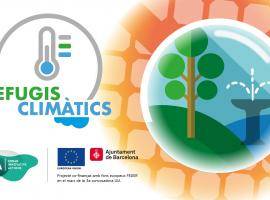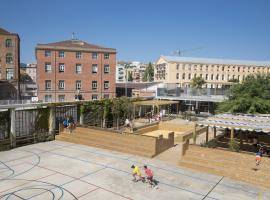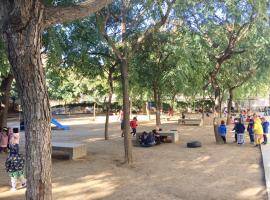All schools converted to Climate Shelters during the UIA project practically act as “Living Labs” as they are open innovation ecosystems in real-life environments using iterative feedback processes to create sustainable impact. They expose blue-green-grey solutions on adaptation to climate change (Image 5) and focus on co-creation, rapid prototyping and scaling-up innovations. In this context, they do not act simply as demonstration sites, but they operate as intermediaries among the educational community, citizens, local government agencies and research organizations as well as demonstration sites.
The final countdown of Barcelona's Climate Shelters project - final journal

The project that started with a plan to convert eleven schools to Climate Shelters (“cool islands” within the city web) for heat waves, was eventually integrated to a city-wide plan for transforming school yards and has finally rolled out as one of the main components of the overall policy of the City of Barcelona for adaptation to climate change.
Executive Summary
The Climate Shelters project implemented an innovative adaptation plan to climate change through the conversion of schoolyards to “cool islands” (termed as Climate Shelters) primarily with a mix of blue (water points), green (greenery in the courtyards), grey (interventions on the buildings, more shadow spaces and use of permeable materials) measures. Through the project, eleven schools were converted into Climate Shelters; as a result, 4.500 kids benefited from the pilot investments in their school, 3.213 m2 of schoolyards were transformed, 74 trees were added, and 26 new water points were installed.
During the entire duration of the Climate Shelters project, a wide communication program was deployed to inform the public on the potential and objectives of the project and raise awareness to climate change and its impacts. Under the leadership of the City of Barcelona, all partners (Image 1) delivered valuable tools and products (https://www.uia-initiative.eu/en/uia-cities/barcelona-call3) in support of the implementation of the project.
Image 1. The Climate Shelters project partners.
Project’s progress
The project organized its final event on October 6, 2022 (Image 2). During the event the main achievements were discussed, and the evaluation results were presented to the educators from the participating schools.
Image 2. Final event of the project at the Villa Olimpica (October 6,2022).
The project in its concluding phase has focused on the assessment of the evaluation findings at the participating schools:
- what is the new state of the local environmental conditions (temperature, indoor and outdoor air quality),
- the health and well-being of the education community and
- the dynamics and life experiences of students and teachers (are the schools more inclusive; do the new playgrounds promote the equality of children in the school yards).
Educational activities were continued at all participating schools (Image 3). More than ten schools are converted every year to Climate Shelters through the legacy city project named “Let’s transform the school yards” (see next section on Long-term sustainability), while the project has been connected to the Open Schools Yards and the Sustainable Schools projects of the City of Barcelona, a fact which facilitated its integration to the overall policy of the City of Barcelona.
Image 3. Educational activities within the Climate Shelters project.
Long-term sustainability
A critical parameter for the long-term sustainability of the Climate Shelters project has been the solid political commitment of the City of Barcelona towards the upscaling of the project. Considering the success of the project from all of its aspects (climatic, environmental, educational, pedagogic, social), a target objective has been added to the city’s Climate Plan, namely the provision of a Climate Shelter at a 10-minute walking distance by 2030.
Annual funding has been earmarked for the upscaling of the project, by means of its integration to the “Let’s transform the school yards” program (Image 4). This program transforms a minimum of 10 schoolyards each year to reach three distinct, yet strongly interrelated, targets:
(a) the physical spaces to become Climate Shelters and therefore greener, naturalized, shaded and with improved thermal comfort both in the inner and outer school environment;
(b) the dynamics and life experiences of children in the school yard to bring them closer to nature and to promote more equal relationships through the diversification of education, sport and play possibilities and activities; and
(c) the school yards to open to the neighbourhoods so that everybody can make use of them for activities.
Image 4. Transformation of Aura school based on the Climate Shelters approach.
Generated knowledge
The Climate Shelters project complied, following detailed research and analysis, a dedicated catalogue (Image 6) on blue-green-grey solutions to adapt schools to climate change. The catalogue reflects the wealth of knowledge gained throughout the project both from the scientific analysis of the schools’ environment as well as the interaction with climate planners and architects.
Image 6. Catalogues of solutions for the Climate Shelters project (left); a solution combining shadow and vegetation in buildings (right); Source: Espais educatius exteriors, Barcelona Education Council.
The project promoted the installation of environmental (for indoor and outdoor air quality) measuring equipment in each of the 11 schools participating in the project (Image 7). The methodology that was applied, consisted of five steps: data collection, quantification of the available data, filtering and data cleaning, data validation and correction (for instance testing the equipment prior to its installation against a reference one) and data analysis. The aim of the air quality monitoring system was to define the concentrations of various chemical species and promote corrective actions in view of protecting the health of students and teachers.
Image 7. Environmental measurement equipment for defining and improving indoor/outdoor air quality.
A list of indicators was prepared to support the assessment of the project in terms of the adaptation of schools to climate change, the inclusiveness of schools, the promotion of climate justice, the success in bringing nature-based solutions in the city, the awareness of pupils and teachers on climate change and finally on the replication potential of the project. Some of the indicators are quantitative and require periodic measurements; others are qualitative and aim to capture feelings, perceptions and sentiments. The list gives weight to the state of both the outdoor and indoor school environment (https://uia-initiative.eu/en/news/indicators-tools-adaptation-climate-change-city-scale-climate-shelters-project-city-barcelona)
The project designed and implemented a thoroughevaluation process that addressed the thermal performance of the schools prior and following the implementation of the blue, green and grey interventions (see Image 8; for more information see https://www.uia-initiative.eu/en/news/evaluation-indispensable-component-innovation-projects), and also assessed indoor and outdoor air quality. Main findings of the evaluation process include:
- The interventions have overall improved the thermal conditions in the school yard.
- The perception of the school's air quality has improved among the teaching staff.
A major innovation of the evaluation process was its attention to changes in the attitudes and feelings of students and teachers following the transformations for the conversion of the schools to Climate Shelters, in view of a better understanding of school dynamics. Major findings of the evaluation process are:
- Transformations have improved the feeling of warmth and well-being in the school (both in the playground and in the school’s interior), among boys and girls.
- Transformations have reduced the levels of more intense physical activity but have increased diversity opportunities to play in the playground and have improved egalitarian relationships.
Image 8. Comparison of the temperature field at the Escola Rius i Taulet prior and after the interventions.
Lessons learned
Some recommendations for projects to be successfully implemented at the city level and secure their legacy in city planning, include:
- Integrate the project to an overarching climate strategy
- Take note of city dynamics
- Capture users’ requirements
- Trust co-creation and participatory processes
- Demonstrate findings
- Drive the potential of the public sector
- Involve knowledge institutions to bring in best practices and promote innovation
- Consider upscaling from the early stages of the project
- Take note that creating a legacy is much more than the tangible results; intangible results such as citizens’ awareness and engagement are equally, if not more, valuable for a project’s legacy.
Conclusion
The Climate Shelters project demonstrated that it is feasible to introduce innovation at the city level to adapt to climate change and improve the city’s resilience to extreme climate events. It also showed that once a project is part of an overarching policy, the chances for its success are considerably strengthened.
The project deployed a well-structured management system that facilitated the smooth communication among the partners, allowed actions to be re-oriented or modified without loss of momentum and/or implementation time.
By applying well designed participatory processes at the school environment and the neighbourhood scales supported by a creative communication strategy, ownership of the project was developed, and support was gained from the local population and various stakeholders, a fact which is of great importance for ensuring the continuity of the project upon its completion.
The main legacies of the Climate Shelters project include citizens awareness and engagement at the neighbourhood scale, the catalogue of solutions to adapt a school to climate change, the model for co-creation and participatory processes, the set of monitoring indicators, the integrated evaluation methodology, and the upscaling “architecture” as deployed, even before the end of the project, by means of integrating the Climate Shelters project to the Let’s transform our school yards project.


























